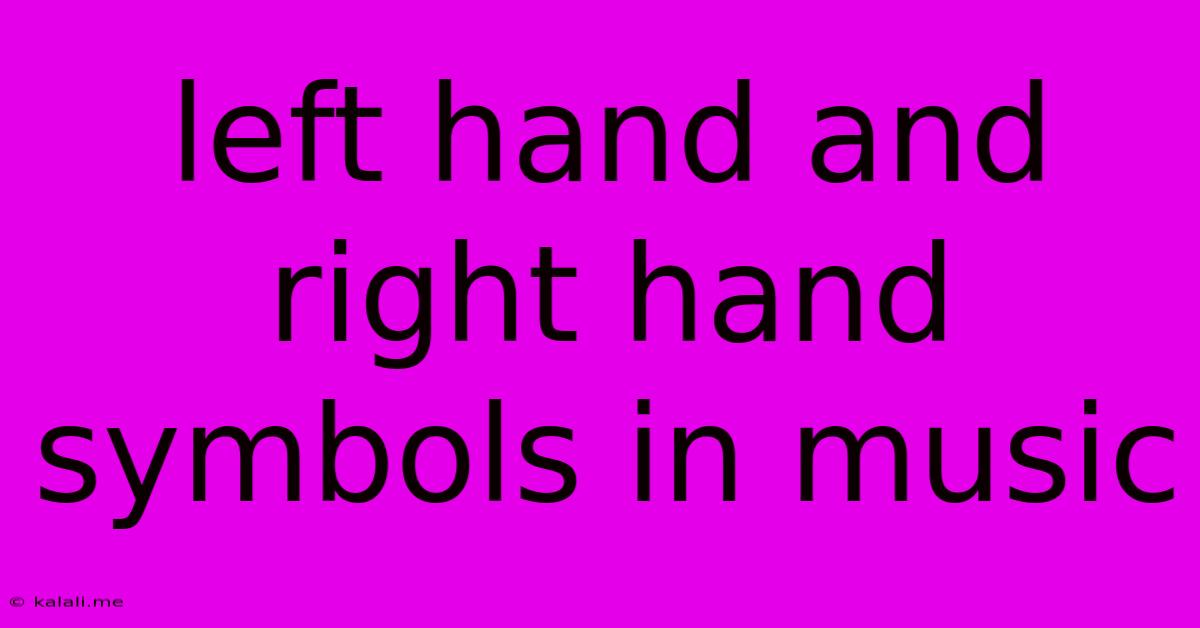Left Hand And Right Hand Symbols In Music
Kalali
May 23, 2025 · 3 min read

Table of Contents
Left Hand and Right Hand Symbols in Music: A Comprehensive Guide
Meta Description: Unlock the secrets of left and right-hand symbols in music notation! This guide explores their meaning, function, and importance for musicians of all levels, covering everything from basic understanding to advanced techniques. Learn how to decipher these symbols and improve your musical performance.
Music notation, at first glance, can seem like a complex language. But understanding its symbols is key to unlocking musical expression. One crucial aspect often overlooked, especially by beginners, is the specific notation used to indicate the roles of the left and right hands, particularly in piano music. This article delves into the various symbols used to represent the actions and functions of each hand, ensuring a clearer understanding of musical scores.
Understanding the Basics: Why Separate Hand Notation Matters
In instruments like the piano, organ, or keyboard, both hands play independent but interwoven parts. The right hand often carries the melody, while the left hand provides harmony, rhythm, or bass lines. Accurate notation for each hand is crucial for proper execution and interpretation. Without clear distinctions, the musical piece would be impossible to play correctly. The symbols aren't just decorative; they are essential for conveying the composer's intent and achieving the desired musical effect.
Common Symbols for Left and Right Hand Differentiation
While there isn't a single universal symbol solely dedicated to identifying the left or right hand in isolation, the context within the musical score makes the distinction clear. Here's how:
-
Stave Placement: The most fundamental method is the use of two staves. The upper stave is generally for the right hand (usually playing the melody or higher notes), and the lower stave is for the left hand (often playing chords, bass lines, or accompaniment). This is the most common and readily understood way of distinguishing the parts.
-
Clef Indication: The type of clef also indicates the hand. A treble clef (often a G clef) usually denotes the right hand, while a bass clef (often an F clef) typically indicates the left hand. This is especially evident in piano scores.
-
Voice Labeling (Occasionally): Some complex scores might explicitly label the staves as "R.H." (Right Hand) and "L.H." (Left Hand). This is less common in simpler pieces but is helpful in more advanced compositions where multiple instruments or hands might play simultaneously.
-
Articulation and Dynamics Marks: While not specifically hand symbols, articulation marks (like staccato, legato) and dynamic markings (like forte, piano) are placed above or below the notes on each respective stave, clarifying the intention for each hand individually. This allows for nuanced interpretation of the piece.
Advanced Techniques and Nuances: Beyond Basic Notation
As musicians progress, they encounter more nuanced notation. Here are some examples:
-
Octave Transposition: Sometimes, a hand may play notes an octave higher or lower than written. This is usually indicated with specific symbols or instructions in the score.
-
Chord Symbols: Above the stave, often abbreviations are present representing chords (e.g., Cmaj7, Gm7). These inform the pianist of the intended harmony, helping to determine the left-hand voicing.
-
Pedal Indications: For piano music, pedal markings (like ped. or una corda) are crucial, often indicated above the stave and impacting the left hand's role in sustaining notes.
-
Broken Chords: Instead of playing a full chord simultaneously, a broken chord (arpeggio) might be indicated, requiring careful interpretation of the order of notes for the left hand.
Master the Symbols, Master the Music
Understanding the symbols used to denote the left and right hand in musical notation is paramount for successful music performance. From the basic use of staves and clefs to more advanced techniques, mastering these elements unlocks a deeper understanding and appreciation of the composer's intent, leading to a more expressive and accurate musical interpretation. Consistent practice and a keen eye for detail are key to deciphering the nuances within the score and ensuring a proficient and enjoyable playing experience.
Latest Posts
Latest Posts
-
Why Arent Subscripts Reduced In Covalent Compounds
May 23, 2025
-
Dick Turpin Wore A Mask Saying
May 23, 2025
-
Multiple Ways To Skin A Cat Synonyms
May 23, 2025
-
Audioslave I Am The Highway Meaning
May 23, 2025
-
No Crank No Start No Click
May 23, 2025
Related Post
Thank you for visiting our website which covers about Left Hand And Right Hand Symbols In Music . We hope the information provided has been useful to you. Feel free to contact us if you have any questions or need further assistance. See you next time and don't miss to bookmark.